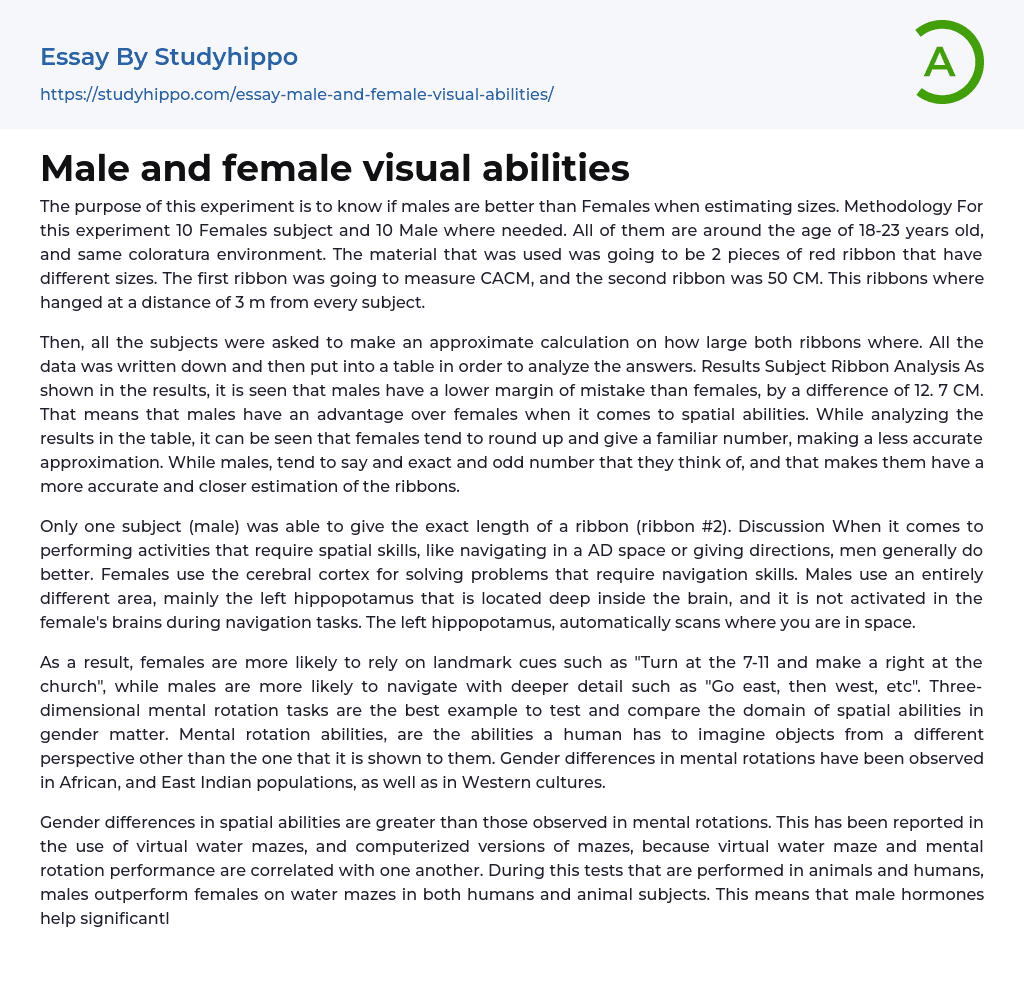The purpose of this experiment was to compare the accuracy of size estimation between males and females. A total of 10 female participants and 10 male participants, ranging in age from 18 to 23, participated in the experiment under the same conditions. Two red ribbons with different sizes (one measuring CACM and one measuring 50 CM) were used as materials. These ribbons were positioned at a distance of 3 m from each participant. Participants were instructed to estimate the size of both ribbons. All data collected was recorded and compiled into a table for further analysis.
The results revealed that males had a smaller margin of error compared to females, with a difference of 12.7 CM. This suggests that males have an advantage in spatial abilities. Upon reviewing the table, it is apparent that females tended to round up their estimations and provide familiar numbers, resulting in
...less accurate measurements. Conversely, males tended to provide exact and odd numbers, leading to more precise and closer estimations of the ribbons. Only one male participant accurately stated the length of one ribbon (ribbon #2) out of all participants.
In terms of discussion, men tend to excel in tasks requiring spatial skills like navigation or giving directions while women rely on their cerebral cortex for problem-solving related to navigation instead. Men activate a distinct region in their brain called the left hippocampus during navigation tasks whereas women do not engage this region automatically when navigating space.
Consequently, women rely more on landmark cues for giving directions while men use more detailed instructions. Three-dimensional mental rotation tasks are effective in examining and comparing spatial abilities based on gender. These tasks involve visualizin
objects from different perspectives. Gender disparities in mental rotations have been observed across various populations including African, East Indian, and Western cultures. Spatial abilities show greater discrepancies between genders compared to mental rotations.
Studies involving virtual water mazes and computerized maze versions demonstrate that performance positively correlates with mental rotation abilities and males consistently outperform females on these tests. This suggests that male hormones play a significant role in enhancing spatial ability as this finding holds true for both human and animal subjects alike.
The above-mentioned experiment confirms that males have an advantage over females due to higher levels of male hormones. These hormones enhance the functioning of the left hippocampus and cerebral cortex. The results also confirm the initial idea and hypothesis, showing that males have better knowledge about table navigation, spatial location, and required movement distance.
As a result, males have a higher success rate in completing the test with fewer errors.
- Experiment essays
- Explorer essays
- Hypothesis essays
- Observation essays
- Qualitative Research essays
- Research Methods essays
- Theory essays
- Caste System essays
- Citizenship essays
- Civil Society essays
- Community essays
- Culture essays
- Deviance essays
- Discourse Community essays
- Female essays
- Filipino People essays
- Igbo People essays
- Indigenous Australians essays
- Indigenous Peoples essays
- Men essays
- Middle Class essays
- Minority Group essays
- Modern Society essays
- Popularity essays
- Social Control essays
- Social Institution essays
- Social Justice essays
- Social Norms essays
- Social Responsibility essays
- Socialization essays
- The nation essays
- Bacteria essays
- Biotechnology essays
- Breeding essays
- Cell essays
- Cell Membrane essays
- Cystic Fibrosis essays
- Enzyme essays
- Human essays
- Microbiology essays
- Natural Selection essays
- Photosynthesis essays
- Plant essays
- Protein essays
- Stem Cell essays
- Viruses essays
- Agriculture essays
- Albert einstein essays
- Animals essays
- Archaeology essays




